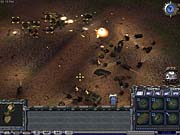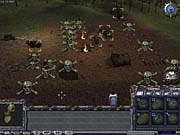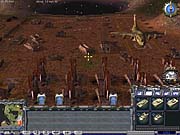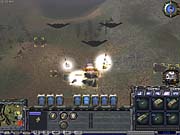Do you like Red Alert 2's real-world whimsy but not its cartoony panache? Is science fiction too outlandish, fantasy too geeky, and history too dry? Would you like real-world considerations like ammo, time of day, and weaponry to figure into your tactics? Do you want to minimize resource management and face a challenging artificial intelligence? And do you like flashy graphics? Although World War III: Black Gold is the only real-time strategy game to meet all these criteria, you don't have to be picky to appreciate it. It's an all-around great real-time strategy game that also happens to stand out from other games in the genre.

Topware Interactive's Earth 2150 and its follow-up, The Moon Project, were among real-time strategy's best kept secrets. Although very popular in Germany (they were developed nearby in Poland), they didn't catch on very well in North America. When Topware collapsed earlier this year after some financial mishaps, it seemed that would be the end of its fine work. Not so. Newly reorganized under the unfortunate name Reality Pump, the company has engineered its Earth 2150 engine into something with a tighter focus and a real-world appeal. World War III: Black Gold is both a worthy sequel to the earlier games and a great game on its own merits.
Never mind the back story, which is a superfluous device to pit Russia, the US, and Iraq against each other. Each of these three sides uses tanks and helicopters as their meat-and-potatoes units. The Russians, who are skilled at field repairs, get regenerating vehicles. They use chemical weapons that bypass armor and kill enemy crews so they can capture their vehicles. The Iraqis can camouflage their units for stealthy maneuvers and ambushes. They also get truck bombs and SCUD missile launchers. The US gets long-range mortars and structures that can call in powerful air strikes from F-15s and batwing B-2 bombers.

Few of these advantages are hard and fast, though. World War III blurs the distinction between the sides, and you'll have access to different tactics no matter which side you're playing. For instance, the Russians have their own SCUDs and bomber air strikes. The Iraqis get chemical weapons, too. The US has a stealth helicopter perfectly suited for ambushes and sneak attacks. But each skirmish will play out differently depending on how you spend your money to unlock the branches of your tech tree. Do you research powerful tank ammo or missiles? Do you try for the chemical weapons or the air strikes? Do you focus on helicopters for speed or mortars for range? And how much should you spend trying to counter what your opponent might be doing? Do you research filters to counter chemical weapons or flares to counter missiles? Will you need a communications center to counter jammers? Should you upgrade your Stinger antiair missiles or your TOW antitank missiles? The beauty of World War III is that it forces you to make choices that have a significant impact on how the game plays. In fact, whether you win or lose can be determined by these choices just as much as it's determined by how much "gold" you gather. In many real-time strategy games, the gold is almost the sole deciding factor.
The "gold" in World War III is oil, the game's only resource. You simply build a pump on an oil well and the money rolls in automatically. Earth 2150 and The Moon Project were unbalanced because one side gathered money using this hands-off method while the other two sides had to manage the sci-fi equivalent of peasants hauling the resources from a mine to a refinery. This extra step of busywork has been completely removed from World War III, and the game is much better for it.
In fact, a lot of things from Reality Pump's (Topware's) earlier games have been streamlined. You don't have to dig tunnels under the map. There are fewer funky weapons like Moon Project's earthquake generators and sonic cannons. There is no naval combat (although some vehicles are amphibious). You can still customize units with various weapons and equipment, but there aren't as many choices. The tech trees have been slimmed down considerably. Shuttling units between multiple maps doesn't figure in as prominently. With fewer structures, there is also a lot less busywork with base building. There's a simplified power system in which you have to build one power generator for every two buildings. The end result is a more accessible game. Earth 2150 and The Moon Project probably overwhelmed some players with the sense that they were playing a wide-open science fiction construction set instead of a real-time strategy game. World War III has a much tighter focus.

This means you can spend more time with the more gratifying business of managing units. The interface is as sleek as ever. You can choose basic or advanced menus depending on how much fine control you want over unit behaviors. Like the last two games, World War III lets you assign units to a control group before they're built. This means you don't have to keep incorporating newly built units into your groups. Here's to hoping more real-time strategy games pick up on this helpful shortcut.
The AI is still excellent, both for friendly and enemy units. Much of the single-player campaigns are scripted, and some of the missions play as puzzles. However, the skirmish games are a real testament to the flexibility and tenacity of the AI. Although the enemies have a propensity to rush early, often, and sometimes blindly, they know how to put up a fight for the locations of important resources. The AI of friendly units is a joy to behold after seeing it done poorly in so many other games. Units will automatically call for resupply choppers. Repair vehicles will go where they're needed. Units inherently know how to use roads for faster travel, and even move out of the way for each other when another unit needs to pass through a crowded area.
World War III makes excellent use of its 3D engine. The maps are built around an obvious grid system, so base building and formations are easy to manage. It's always clear what fits where, and it's aesthetically satisfying when the units don't just randomly clump up in small spaces. Terrain and structures never obscure units if you're zoomed all the way out. The camera is flexible enough to let you see the action from different angles without losing track of what you're doing (a single key snaps everything back to the default view). Even when you zoom in, the textures and polygons stand up under scrutiny. Some players might be put off by the fact that many of the units look alike. There's not a lot you can do to distinguish basic tanks, jeeps, and helicopters from each other, but Reality Pump has done as good a job as can be expected. And the pyrotechnics look as good as ever.

Ever since Earth 2150, Reality Pump's games have had awful manuals. World War III is no exception. There's little information on how the different units' special abilities work. Parts of the interface aren't explained. New tooltips on the tech tree and build menus are helpful, but only in a general way. You'll still have to go through a lot of trial and error to figure out how everything works. Also, the game's voice-overs are awful, ranging from cheesy to offensive. There's no more of the Stepin Fetchit burlesque from The Moon Project, but now the Iraqi truck bombers give out an "Allahu akbar" before blowing themselves to smithereens.
But World War III is good enough that it could get away with a whole lot worse. If you're acquainted with Reality Pump's previous games, you might be worried that World War III is essentially a mod for Earth 2150. After all, The Moon Project was very similar to its predecessor. But World War III is a whole new game with an awful lot to recommend it. Whether you're familiar with the developers' previous games or not, if you're a real-time strategy gamer, rest assured that this is one of the year's better games.